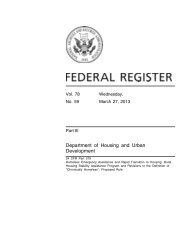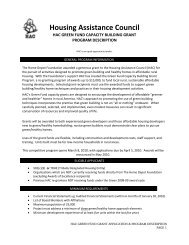Public Relations Guide for Rural Housing Organizations (manual
Public Relations Guide for Rural Housing Organizations (manual
Public Relations Guide for Rural Housing Organizations (manual
Create successful ePaper yourself
Turn your PDF publications into a flip-book with our unique Google optimized e-Paper software.
Op-Ed PieceThe term “op-ed” comes from the literal description of where this type of article is placed in thenewspaper – opposite the editorial page. Op-ed pieces may be most effective when theymention by name the people in your community who are most likely to read them: politiciansand officials. For local newspapers, it is best if the op-ed addresses a community-wide timelyconcern, such as an upcoming vote or the release of a new housing study, or if it points to achange in housing legislation. It is important <strong>for</strong> the writer of an op-ed to be on top of thenews.Competition <strong>for</strong> op-ed pieces comes from syndicated columns; as a local community “expert,”you have a head start in providing an article that will appeal to local readers.Most op-eds do not get into print because they are too dull (Center <strong>for</strong> Community Change1997, 49). Be sure your piece is lively, and even provocative, to hold the reader’s attention. Tohelp assure that it is printed, attempt to have your article “signed” by a local community orbusiness leader who is on your board of directors or a local politician. This is not the place togain name recognition <strong>for</strong> yourself! Think of someone who is well respected in yourcommunity; your cause will gain instant recognition if it is fully supported by a well-known“voice,” especially if such an endorsement is unexpected or unusual. Give the reader animmediate reason to want to read your article.Include a brief biography of the author that emphasizes the person’s expertise. Mentionawards received and books written. Include a cover note explaining the timeliness of the pieceand why local readers would be interested in it.The op-ed should follow many of the same guidelines as a letter to the editor. You should callthe editor of the opinion page to discuss the piece be<strong>for</strong>e writing it, to determine interest,length, and timeline. Op-ed pieces allow more words (700 words – about three pages, doublespaced)than letters to the editor. If your idea is accepted, you are usually given theopportunity to do some editing be<strong>for</strong>e it is printed. In a smaller newspaper, your piece may beedited <strong>for</strong> you.Your local newspaper is likely to have a separate editor <strong>for</strong> the op-ed page only if the paper hasa circulation of 40,000 or more; otherwise, it might be best to submit your piece to severalpeople at the same newspaper to assure success in getting it printed. It might be just aseffective if a reporter decides to make it into a news item (Zeck 1991a). If you have had noresponse within one or two weeks after submitting it, call to find out if it will be used (Center<strong>for</strong> Community Change 1997).If the timing in a public debate or crisis is just right, it might be worth investing money topurchase space in a print medium to assure that the op-ed is published. The piece can then bereferred to very effectively, especially if it has persuaded community leaders to make significantpositive changes.24 <strong>Public</strong> <strong>Relations</strong> <strong>Guide</strong>









